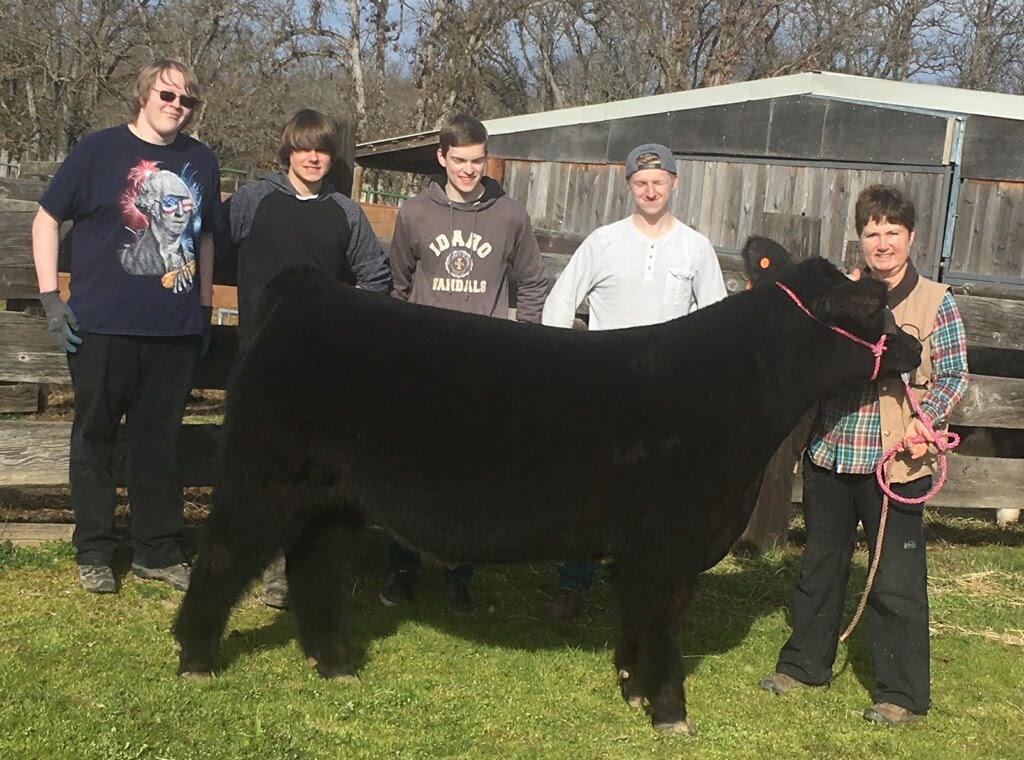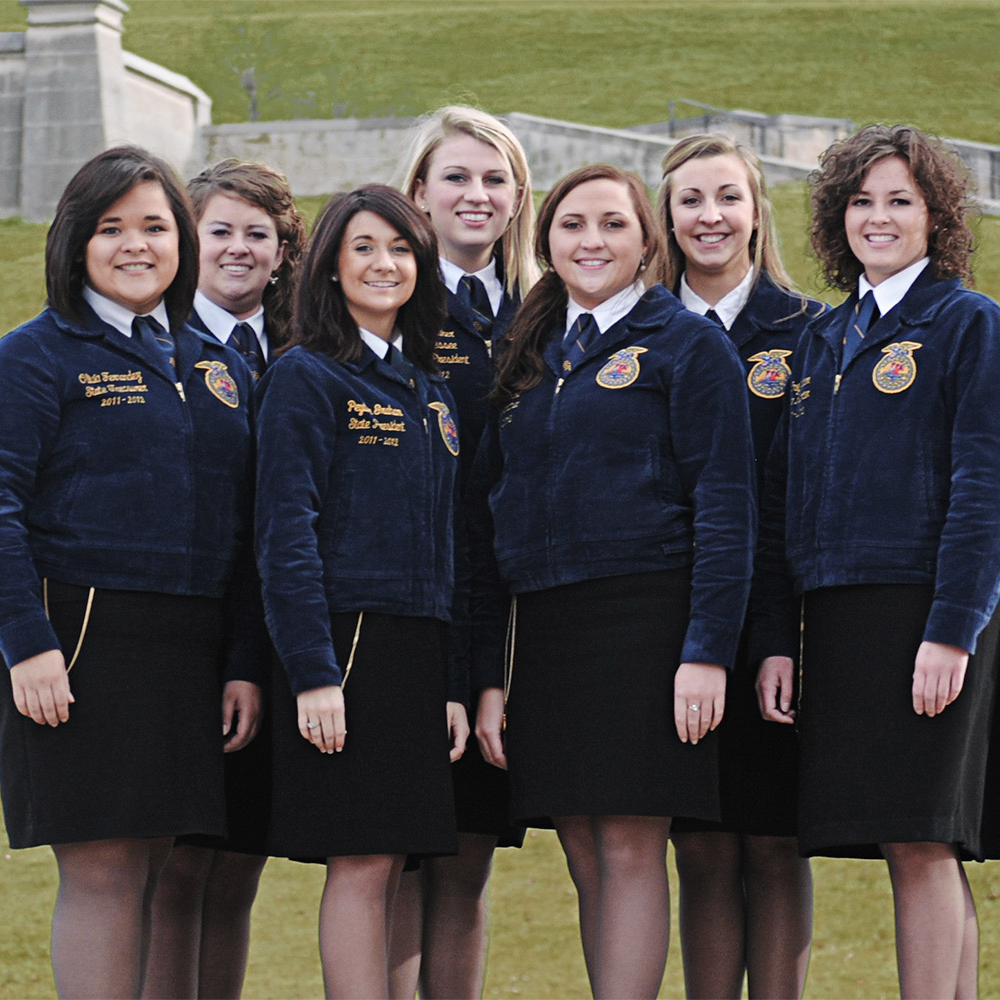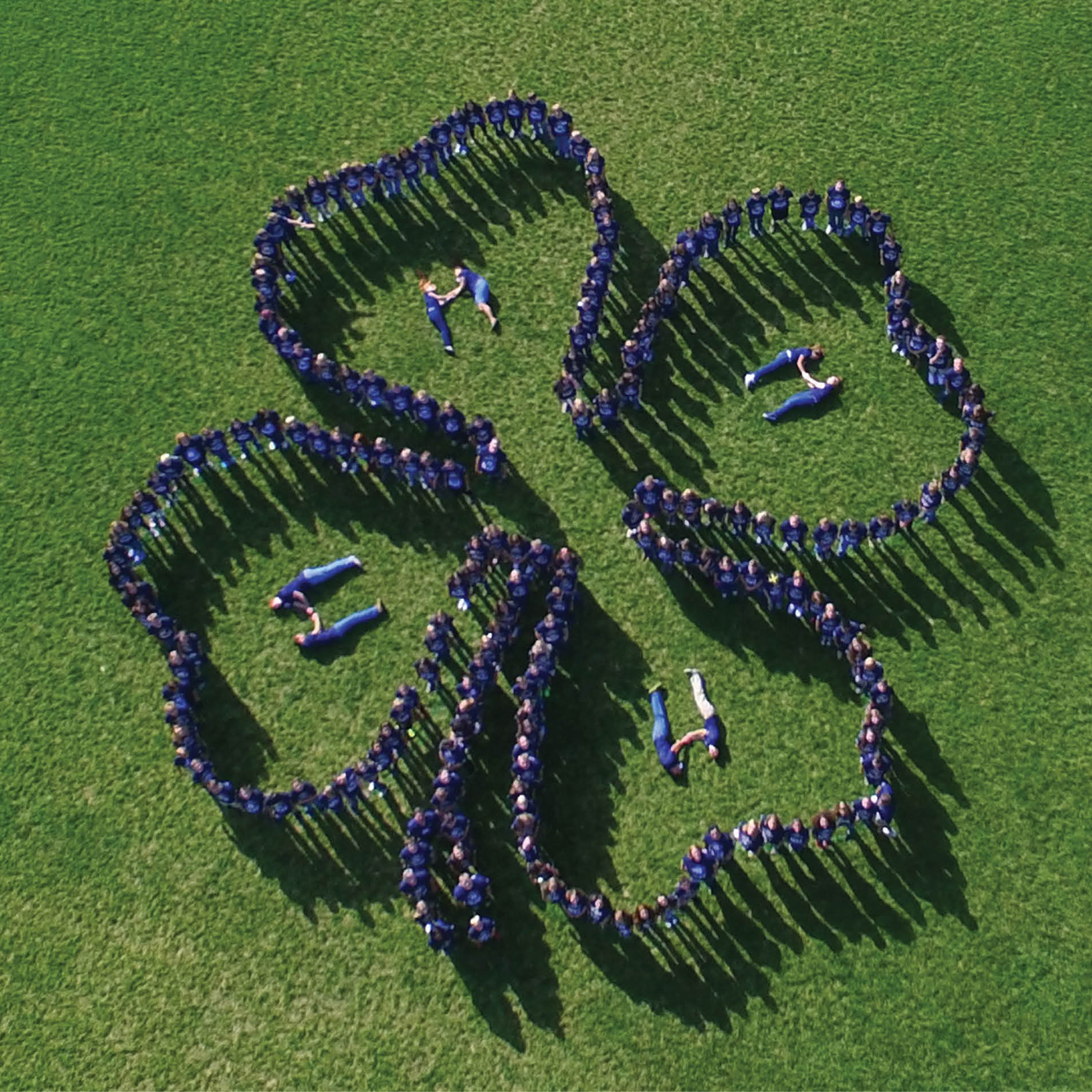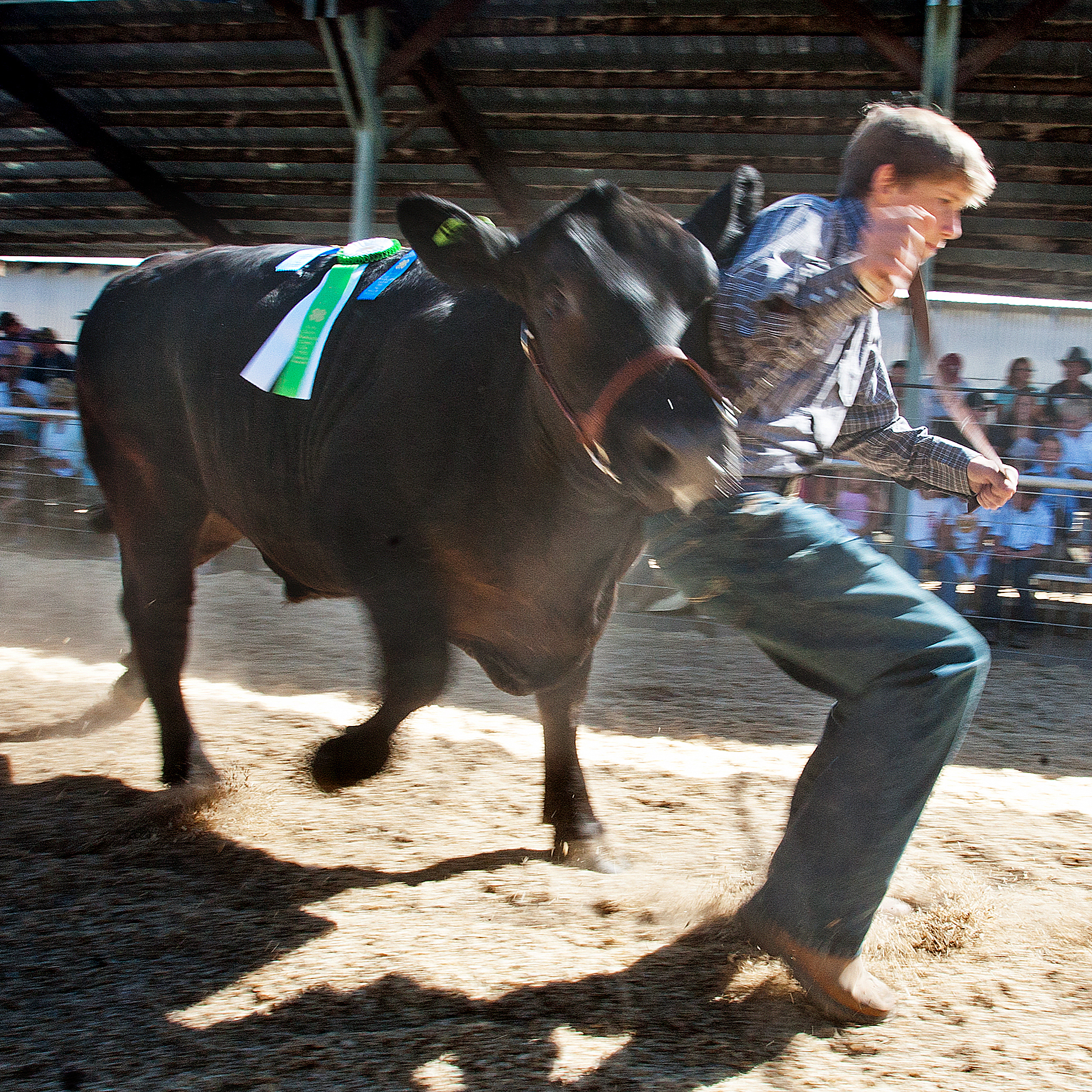
GLADMAN LIVESTOCK, THE NATIONAL FFA ORGANIZATION, AND 4-H
Gladman Livestock is a small company that performs farming operations based in Central Point, Oregon at Gladman Ranch. The ranch that the company works at is home to over 30 cattle, made up of calves, steers, and heifers. The workers on the ranch specialize in producing show heifers and steers for both FFA and 4-H members in Oregon and California. The organization is now a fifth-generation farming operation that endeavors to develop show calves of the highest caliber while also still caring for the land and water in the area for the pending future generations.
The National FFA Organization is an intracurricular organization for students and those who are interested in developing and adding onto their knowledge and skills in leadership and agriculture. The FFA’s website states that this “is one of the three components of agricultural education.” The National FFA Organization provides a fast and hard-fought lane to accomplishment in career/course prosperity, personal and particular advancement, and predominant leadership, management, and administration all through agricultural education.
4-H is a non-profit organization and global network of organizations in their youth with the mission of "engaging youth to reach their fullest potential while advancing the field of youth development." The 4-H name embodies the organization’s four particular and personal development areas of strong focus and lead direction for anyone that implements this idea: head, heart, hands, and health.

MISSIONS
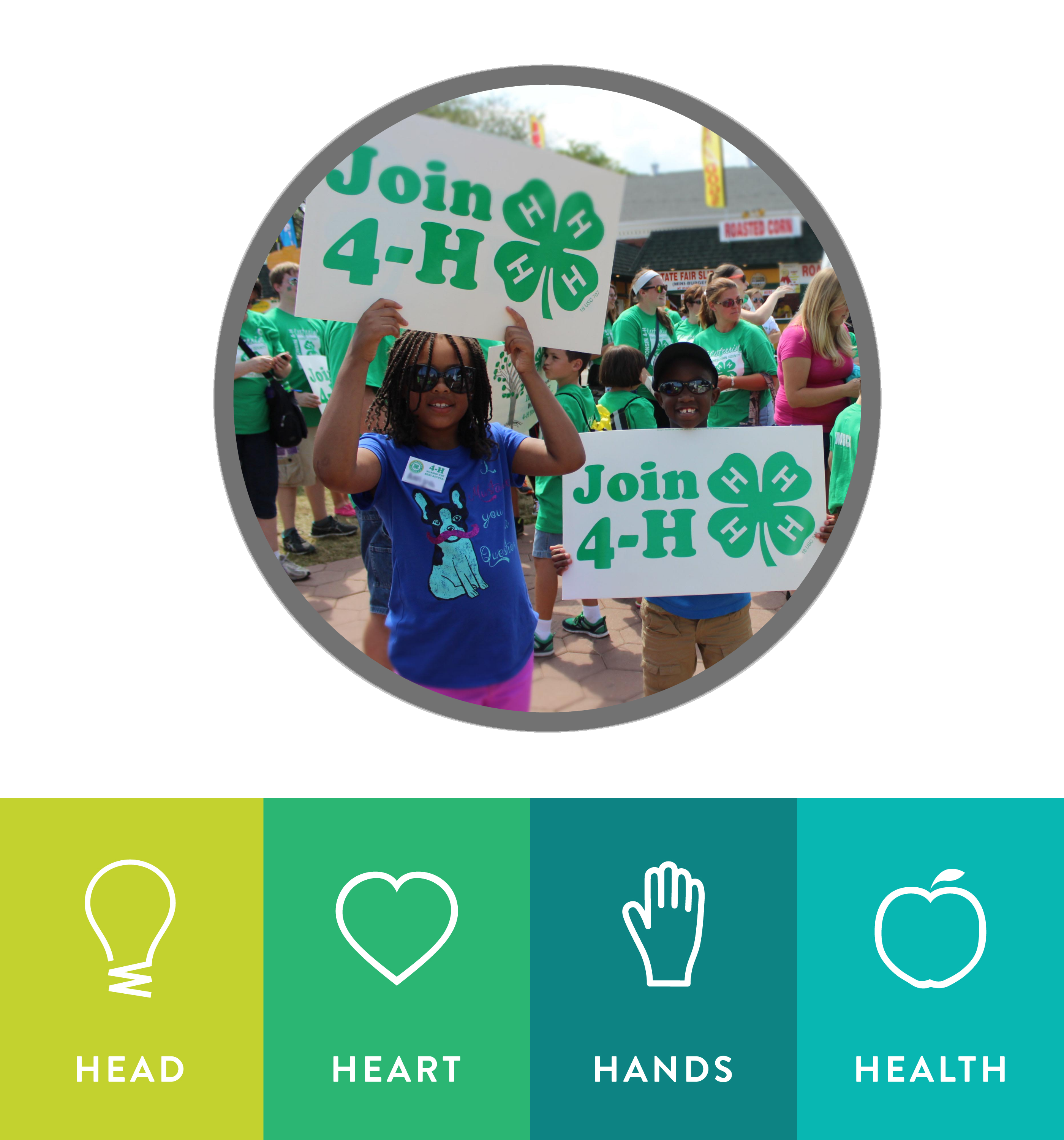
VISIONS
The vision of the National FFA Organization is “Students whose lives are impacted by FFA and agricultural education will achieve academic and personal growth, strengthen American agriculture and provide leadership to build healthy local communities, a strong nation and a sustainable world.”
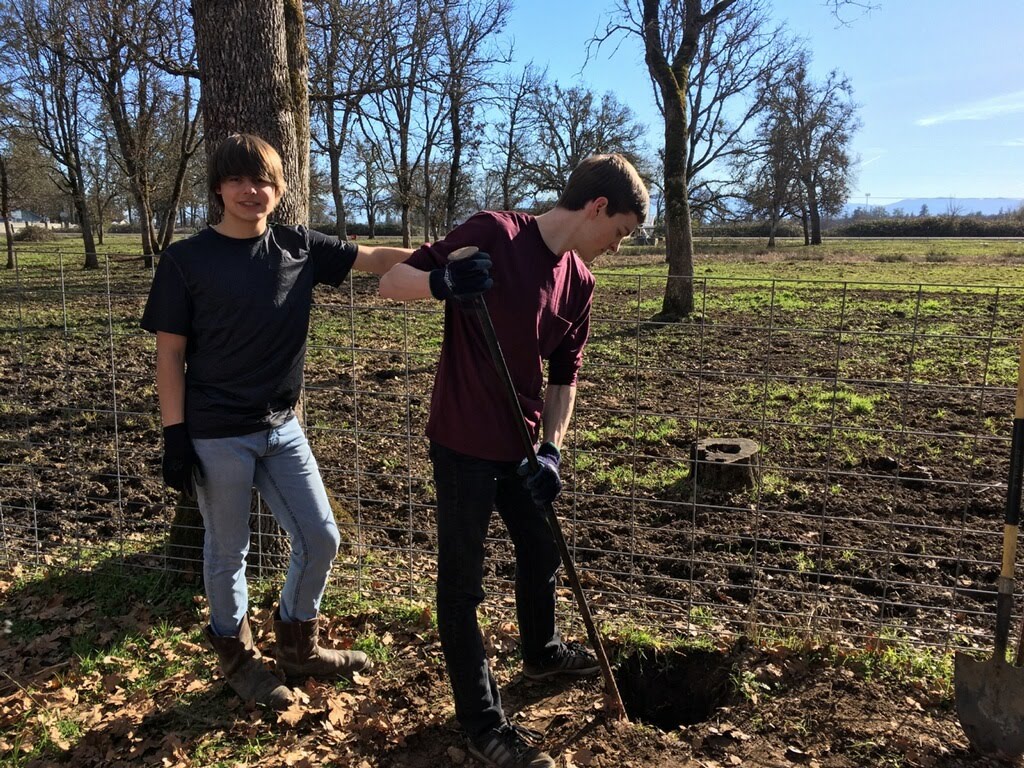
MOTTOS
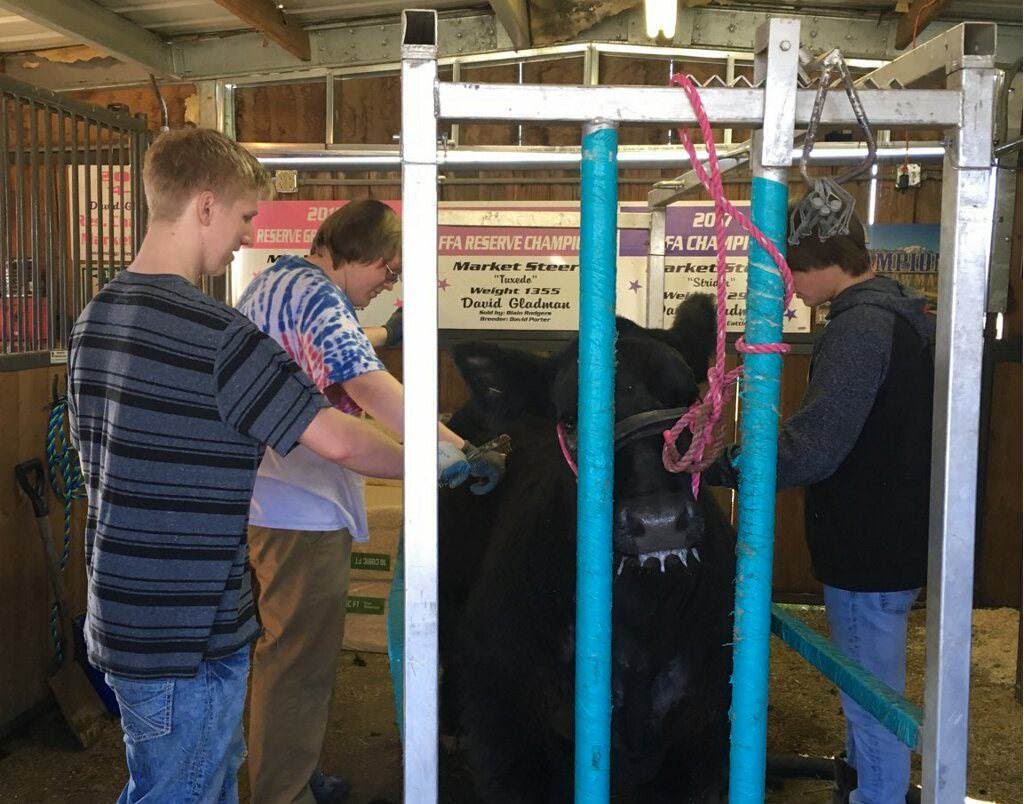
HISTORY
When we asked Lynn Gladman, the woman in charge at Gladman Livestock, about the history of the ranch and how it all started, she gave us a very telling and interesting story that I would just like to quote for the company’s history so that none of the details in the story are lost in translation at all. After this quoted story, I will write a concise version of this story all in my own words (a “TLDR” — too long; didn’t read — if you will). Thank you and enjoy.
“It began with a Nebraska lightning strike in the 1920’s, which killed seven cows in one night. The loss drove Great Grandpa Bohnert to pack up his five sons and travel further west. Eventually, all five boys followed their dad’s footsteps and bought farmland in the Rogue Valley. Seven Oaks Farm was developed by the youngest son, my grandfather, John Bohnert. Taking on his youngest daughter, Doreen and her husband, Don as partners in 1954, John farmed until his death in 1987. Seven Oaks Farm is managed today by Don and Doreen Bradshaw and her oldest daughter and son-in-law, Lori and Jerry Mefford. The farm stand is still known countywide for its’ produce, commitment to the community, and legendary sweet corn.
Originally, my grandfather raised onions and corn as well as Hereford cattle. When Interstate 5 was built in the 1950’s he lost a portion of his land for the freeway and purchased the 147-acres I now run. As a small child I can still remember delaying opening Christmas gifts to help feed the cows on this land. I showed cattle in 4-H for seven years before moving on to study at Oregon State University. Graduating from OSU with a business degree, I was commissioned as a Naval Officer and served fourteen years before leaving the service to raise a family.
In 2008, I inherited the 147-acre cattle and hay operation, and along with several of my children, manage 50 cow-calf pairs of Maine Anjou cattle. My oldest son, manages a satellite operation in Glenn, California. We specialize in producing show steers and heifers for 4-H and FFA members in Oregon and California. Gladman Livestock is a fifth-generation farming operation striving to produce the highest quality show calves possible while caring for the land and water for future generations.”
History Gladman Livestock TLDR: Somewhere in the 1920’s, Great Grandpa Bohnert lost cows to a lightning strike in Nebraska and so he and his sons moved west, purchasing farmland in the Rogue Valley. The youngest son, Grandpa John Bohnert, built Seven Oaks Farm and, in 1987, farmed til death, leaving Doreen and Don, his daughter and her husband, as the managers. The farm is still managed today by the same Don and Doreen Bradshaw, as well as their oldest daughter and son-in-law. Seven Oaks Farm is also still known countywide for its produce, community commitment, and sweet corn. Back in the 1950’s, Lynn Gladman’s grandfather was raising onions, corn, and Hereford cattle. Around this time, a portion of his land was lost to Interstate 5 being built nearby and so he bought 147-acres of land elsewhere. In 2008, Lynn inherited those acres and continued the cattle and hay operation with the help of her children. For seven years she showed cattle in 4-H and later on studied for a business degree at Oregon State University. Afterward, she served fourteen years as a Naval Officer, later leaving to come back and have a family and continue running the farm.
The National FFA Organization was founded in 1928 by a group of young farmers (Henry C. Groseclose, Walter Stephenson Newman, Edmund Magill, and Harry Sanders) with a mission to train and formulate the coming generations for feeding the growing population of modern society and the challenges that will be materialized from this. They developed and created lessons on agriculture and how it is more than just planting and harvesting. Agriculture is a science. Agriculture is a business. Agriculture is an art.
4-H was founded in 1902, Clark County, Ohio by Albert Belmont Graham (A. B. Graham), who wanted to start up multiple youth programs that do what the organization still has set for the main goal and focus for today — teaching agriculture in a much more in-depth fashion than usual. It was either the “Corn Growing Club” or “The Tomato Club” that was the name of the first 4-H club created. In 1902, T.A. Erickson of Douglas County, Minnesota, began giving lessons of local agricultural education in various clubs at fairs and after school. Their logo, an H on each leaf of a clover pin, was designed by Jessie Field Shambaugh in 1910 and by 1912, the clubs were then named “4-H” clubs. Their story basically goes the same way and along the same kind of path as the National FFA Organization — they grew larger and larger over time and gained momentum with that building quality.
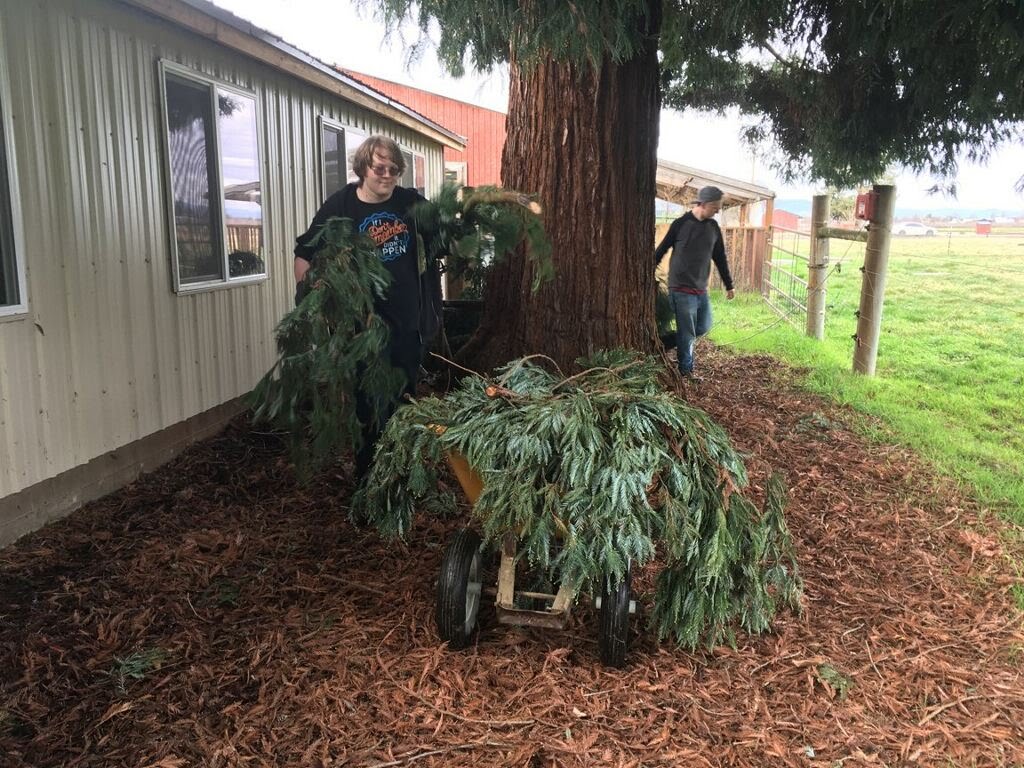
COMMUNITY RELATIONS
Gladman Livestock is involved in the FFA and 4-H community through producing show heifers, steers, and calves, which are then given/sold to the members of those organizations as “products” and contribute possible success to those organizations. They are also involved in the community by occasionally travelling to nearby facilities to help out with some tasks that they may need assistance with. One day, when I and my friends did our internship with Gladman Livestock, we went to the Crater Land Lab to disassemble gates, collect any wood around the place for a bonfire, and clean the muck off of the floor inside one of the buildings. Overall, the main way that the Gladman Livestock organization is associated with the community is with producing show cattle and selling them to those who wish to show them off and win competitions with, such as the FFA or 4-H.
The National FFA Organization and 4-H involve themselves in the community by providing and encouraging agricultural education. They both develop leadership, improvement, and success within their students with the education of agriculture. More specifically, they each offer agricultural education programs in communities that go incredibly in-depth on the reasoning behind agriculture, how important it can really be for our society living today, and how much more there actually is to agriculture than just what everyone thinks it is in general — just harvesting and planting. In conclusion, the National FFA Organization and 4-H both get themselves involved in the community through the building and offering educational classes that are widely available and go very in-depth on agriculture, accepting those who wish to grow up and have a career in that specific field of agriculture.
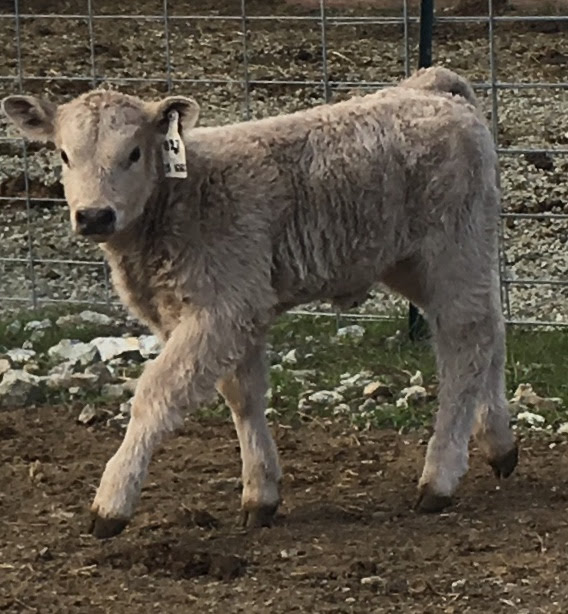
SERVICE DESCRIPTION
Gladman Livestock mainly provides show cattle, from calves to steers to heifers, for different organizations that show them, such as the National FFA Organization and 4-H. Basically, Gladman Livestock has people on the farm/ranch that take care of all the cattle there through feeding them, grooming them, caring for them, etc. To help the cattle look like bigger, better, and fluffier cattle they implement certain techniques into their day to day work that allows for the cattle to naturally gain those qualities that many people want when they are showing cattle. That is practically what Gladman Livestock does — they produce show cattle that gets sold off by caring for the cattle and making them look good for the shows.
The National FFA Organization and 4-H, from what I understand, are both services that primarily teach students who want to grow up and become farmers/ranchers and work in agriculture about agriculture in a detailed manner. They just chiefly teach agriculture to people who want to work in agriculture. 4-H seems to be more of a general “youth development” program while the National FFA Organization goes more in-depth on agricultural education.
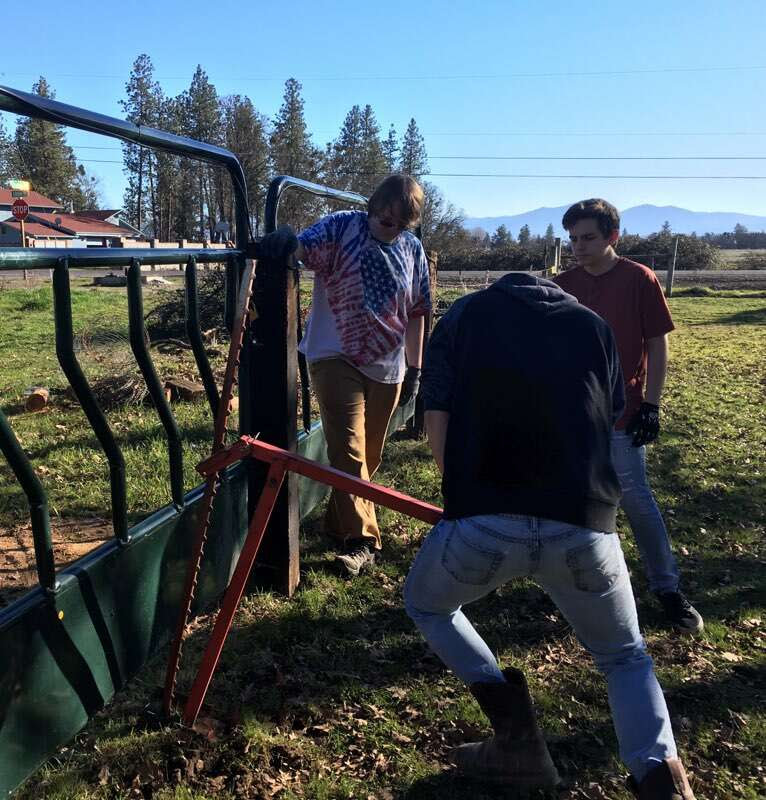
JOB DESCRIPTION
Our job on the ranch did not involve just a few similar styled tasks but involved a variety of different tasks that ranged in pace and difficulty. On a few days, all we would do was put up fences using various tools. The fences were being put up (and some old fences were being replaced) because this helps keep the cattle from escaping and getting separated at times. Wires, pieces of fences, hammers, tweezers, wire cutters, and many other tools were used to build each fence. This means that the way each tool is used must be acknowledged and learned by the individuals using them. The training should just occur naturally as everyone uses each tool and gets a feel for how to use it properly. For example, when me, Garrett, and Patrick, my fellow workers, started out, we did not know how to use each tool very well, but by the end of the internship we figured out how to do different tasks with each tool to their maximum capability. The same process was done when doing the many other tasks we were instructed to conduct.
When we carried heavy bales of hay and grass to the shed for later or to the feeders for feeding, we had to find the most efficient way to do this because, after a couple trips back and forth, it begins to get extremely tiring and taxing on your hands, wrists, arms, and back. Again, the training is just done naturally by doing the task over and over until the individual adapts to the situation somewhere. We began to use wheelbarrows for the super heavy stuff, dragged other bales, and carried some with our arms like normal but also using our legs and knees and a platform that the bale could kind of rest on.
One last task I will talk about is the post hole digging because this one almost came up as often as the others. What we had to do was use different tools, like shovels, a pickaxe, a long needle, and a “post hole digger”, to dig a 3 ft deep hole that was also at least around 1 foot wide for a post that would be put in after. The same procedure and development in the other tasks once again occurred here — we learned how to dig the holes more efficiently by using the tools at our disposal for certain stages that only applied to them.
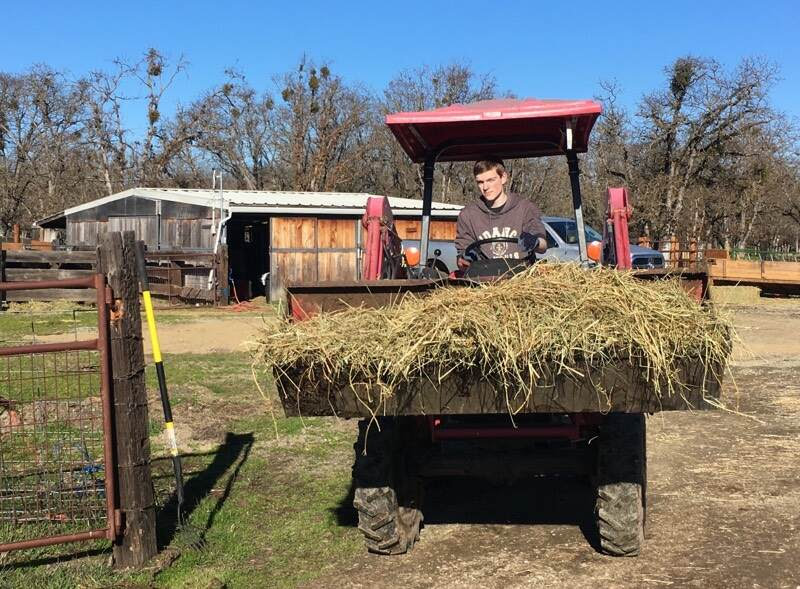
SUPERVISOR INTERVIEW
What are some of the rewarding experiences of your job?
“Ranching has many rewards including saving a newborn calf I was concerned about losing, raising high quality show stock for youth exhibitors who then go on to win their county fair, getting to work outdoors in a job that is constantly changing, leaving the land and water better than when they were passed on to me, and providing an incredible childhood for my children.”
What are the most difficult challenges you face on a regular basis and how do you handle them?
“The biggest challenges are those I cannot always solve despite my best effort - a sick cow that won't get better, a difficult delivery, pasture grass that isn't growing and I don't know why. My solution is to keep learning. Nearly every day, I am reading articles, researching, asking experts questions, or attending workshops.”
Have you ever considered changing careers, why or why not?
“Graduating from Crater, I planned a pre-med major until discovering I simply wasn't that smart. I then graduated college in Personnel Management and Naval Science, got a commission as a Naval Officer and spent 14 incredible years in the Navy. To some degree, I reluctantly, left the service to raise children, seeking flexible hours and a job working from home. When no one else in the family wanted the land, I inherited this cattle and hay ranch. Certainly, there are days, I long for a 9-5 job with benefits, staff, and a more comfortable environment; but this lifestyle offers many advantages and at age 60, the ranch may be my last career move.”
How is your work environment? Do you enjoy where you work?
“When it is a sunny 65 degree, the grass is growing rapidly and the calves are racing each other down the pasture I cannot imagine a better environment. When it is 27 degrees outside and a newborn calf is gasping for his first breath as we try desperately to get him out in time, the environment is less than ideal. On the other hand, you cannot beat the sound of rain on a metal barn roof or the sunset over the Table Rocks with grazing cows in the foreground, or your children's wonder the first time they watch a newborn piglet.”
Is your industry subject to the ups and downs of the economy, and if so, how has it affected you?
“Is there an industry that doesn't experience volatility? The cattle market broke record highs three years ago when drought in the Midwest and fires in Colorado decimated the US cattle industry. My niche in the show stock market suffers less extreme swings but it is still dependent on our production of the highest quality show calves we can produce.”
If you could give one piece of advice about this type of career, what would you say to someone thinking about entering this line of work?
“Get some experience, even if it means "slave-labor" internships! Seek out experts and never stop learning. I wish I'd taken college courses in soils and forage management. Construction classes would have been incredibly useful as well!”
What is your favorite part of your job?
“At the moment, I'm in the middle of calving season so these experiences are especially fresh in my mind. One huge rush is battling for the life of a calf stuck in the birth canal, pulling with every ounce of energy to assist the cow and then standing there an hour later as the calf totters on unsteady legs to nurse for the first time. Sometimes, it is simply driving the tractor while dragging the harrow in circles, watching content cows and knowing you did your best by them. Cattle ranching has given my five children experiences few enjoy today, as well as income and skills, and for several - careers. There are few professions which offer the family lifestyle, farming provides.”
What is your least favorite part of your job?
“Certainly losing an animal is the most unpleasant aspect of ranching. Along with coping with death, is the thought that sometimes I don't have the answers and don't know where to find them. Other times there are a myriad of decisions to make ranging from what kind of vaccine program is ideal to how much winter feed should I buy, or which AI bulls should I use? Each year gets better though, as I gain more knowledge and experience.”
What was the biggest challenge you faced when starting on the ranch?
“I'd say my biggest challenges have been how much I needed to learn. A cattle ranch needs fencing, plumbing, electricity, construction, road maintenance and more and that's just the infrastructure. Then there is the pasture and dry land calling for decisions about fertilizing, herbicide use, and grazing management. Next, we put some cows on the property and need to know about veterinary medicine, vaccines, wormers, breeding, and calving. Wrap up the list with knowledge of record keeping, finances, taxes, and marketing and it is amazing how many skills farmers and ranchers acquire. Additionally, finances are a struggle when I only get paid once a year but I had the land given to me. Most farmers struggle to raise the capital necessary to even start a viable operation in the agricultural industry.”
Anything else to add?
“I hope the students who intern on the ranch get a glimpse of the complexity of the job as well as the dedication of most farmers and ranchers. I hope that someday when they are diving into the perfect steak, they remember how the process starts and how hard most agricultural producers work to give the consumer a product to be proud of. I hope they recall the blisters they gained digging post holes and realize that anything worth having is worth working hard for.”
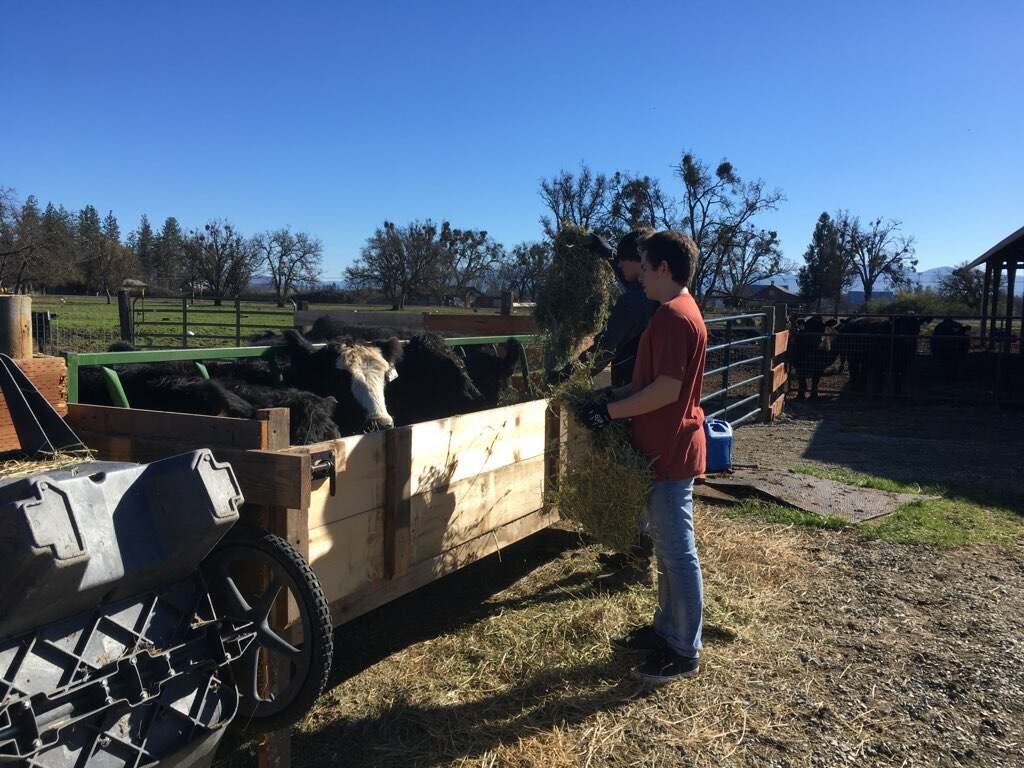
JOB SHADOW NARRATIVE
It’s a Tuesday — internship day. I and the boys are out at lunch. We decided to go to Carl's Jr. that day and after finishing most of our $5 meals, we get in Garrett’s car and drive over to the ranch with all of our gear (boots, jackets, and gloves) in the trunk to start our internship. Once we park, we get out, get everything we need, and head over to Lynn Gladman, our internship supervisor, for our tasks of the day. She started us off on digging post holes and cutting blackberry bushes, so we split into two teams. I, Rusty, and Alex went off to cut some of the terrifying blackberry bushes as Patrick and Garrett stayed behind to begin the two post holes. This day became a very memorable day for me because we did a ton of different tasks and taught us a lot about multitasking and how to switch yourself between gears much more consistently. Also, we learned how to use the few tools at our disposal for those different tasks, such as using a strong bar to swing and pull the blackberry bushes out from the ground.
Once we spent almost an hour cutting all of the huge bundles of blackberry bushes, we made our way back to Alex and Patrick who were about done with one hole. This is where things got interesting for these post holes because we had to split the tools up between us. Once we were in agreement with what each team got, my team went over to where Lynn wanted the second post hole and began digging it. This was also a very interesting experience because we had to use tools that were not as efficient as other in digging but we did our absolute best to make them work. In the end, we finally got each hole done in around an hour and went to Lynn for the details on our next set of tasks.
She now needed us to help her and some other workers out on moving a certain heifer from an area of many to an isolated area. This was really cool and unforgettable because we were able to get right up next to them all and then try to navigate the one heifer to the exit. At one point, someone left the gate for the exit open and some of the heifers started running a train right out of the pen. It was funny but we needed to get them back in, which we did. After we finally got the heifer out and away from the others with the help of David Gladman, Lynn Gladman’s son, taking her baby outside of the pen, we navigated her over to the isolated area for something and then all the way back.
Lastly, we were instructed to carry some bales of hay over to a shed, put some in the feeders for the cattle to eat, and pick up any scraps of wood and metal (including barbed wire and nails) laying around in a certain area. The overall experience of this day was just super cool because we got to do a variety of things very efficiently and quickly with our adaptation using each tool and in every situation thrown at us.
